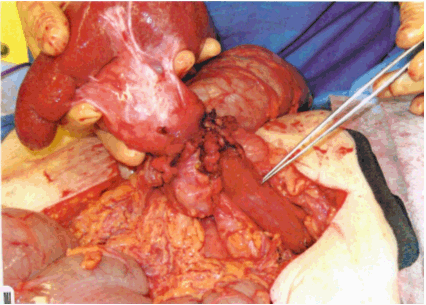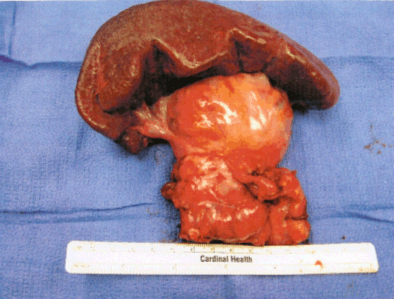| Table of Contents |  |
|
Case Report
|
| Wandering spleen with pancreatic volvulus and colonic obstruction in an elderly patient |
| Rajiv Choudhary1, Ali Ghazanfar1 |
|
1Banner Baywood Medical Center, Mesa, AZ, USA.
|
|
doi:10.5348/ijcri-2012-07-143-CR-4
|
|
Address correspondence to: Rajiv Choudhary 11363 E. Stanton Ave, Mesa AZ 85212 USA Phone: +1-(602)-363 6960 Email: dr.rajivc@gmail.com |
|
[HTML Abstract]
[PDF Full Text]
|
| How to cite this article: |
| Choudhary R, Ghazanfari A. Wandering spleen with pancreatic volvulus and colonic obstruction in an elderly patient. International Journal of Case Reports and Images 2012;3(7):15–18. |
|
Abstract
|
|
Introduction:
Wandering spleen is a rare condition, caused by elongation or maldevelopment of splenic ligaments resulting in splenic hypermobility. Very few cases, if any, have been documented in the elderly population. Herein, we report a case of wandering spleen with pancreatic volvulus and colonic obstruction in an 87-year-old female.
Case Report: The patient presented with recurrent abdominal pain and distension. Imaging done at admission revealed a wandering spleen in the pelvis, with splenomegaly and enlarged splenic vein. An explorative laparotomy was performed, the spleen was found to be in the pelvis, there was a volvulus of the distal pancreas. The pancreas had adhesion bands across the distal tail and there was one particular band that was going across to the descending colon causing an internal hernia and colonic obstruction. A splenectomy with a distal pancreatectomy and subtotal colectomy was performed. Conclusion: Wondering spleen is most commonly seen in children and adults with a higher incidence in women especially in the childbearing age. The cause can be congenital or acquired. The most common presentation in patients with wandering spleen is abdominal pain with associated genito-urinary complaints. Due to the longstanding history of this patient, it is crucial to consider wandering spleen in differential diagnosis of patients with non-specific abdominal pain. It is very important to diagnose such cases early so as to prevent complications, especially in elderly population, where symptoms and signs may not point towards the condition. | |
|
Key Words:
Wandering spleen, Elderly, Pancreas, Acute
| |
|
Introduction
| ||||||
|
Wandering spleen is defined as a single spleen on a long pedicle, in an abnormal position rather than the left hypochondrium where it is normally located. It is characterized by the absence or abnormal elongation of its ligamentous attachments to the diaphragm, retroperitoneum and colon. [1] The true incidence of wandering spleen is difficult to determine due to the rarity of this condition and is estimated to be around <0.2–0.5%, [1] [2] [3] [4] based on the splenectomies performed. Due to migration of the spleen from its normal position, patients can present with recurrent abdominal pain, change in bowel habits, increase in urinary frequency and bowel obstruction. Most of the cases are reported in the pediatric population or in females of childbearing age (20–40 years). [1] [2] [3] [4] [5] We present a case of an elderly patient, 87-year-old female, with a wandering spleen in the pelvis associated with torsion of the distal pancreas and colonic obstruction. | ||||||
|
Case Report
| ||||||
|
An 87-year-old female presented to the emergency department with complaints of increasing abdominal pain for several days associated with persistant abdominal distension and discomfort. She had these complaints for the past few months. She also complained that she had constipation on and off for many years and did not have a bowel movement in weeks. She complained of problems with her gastrointestinal system for many years as far as she could remember. On admission, she had no complaints of nausea/vomiting and did not look toxic. Her past medical history was significant for breast cancer, GERD and constipation and her past surgical history was significant for appendectomy, cholecystectomy and mastectomy. On systemic examination, the abdomen was found to be mildly distended and tender to palpation. There were no masses, no guarding, no rebound and no groin hernias. The rest of the examination was within normal limits. Laboratory findings were within normal limits with a hemoglobin of 13.8 g/dl, platelet count of 1x106/mm3, INR of 1.2, glucose of 101 mg/dl, serum creatinine of 0.73 mg/dl, sodium 139 mEq/L, potassium 3.7 mEq/L and liapse 76 U/L. CT scan of the abdomen and pelvis revealed the spleen to be within the pelvis and the pancreas pointing downwards (vertical). The stomach was pulled down and in the shape of an inverted U. The spleen and the splenic vein were found to be moderately enlarged. At surgery, the spleen was located in the pelvis. The pancreas was completely intraperitoneal and in a vertical position. There was a twist or volvulus of the distal pancreas. The pancreas had adhesion bands across the distal tail and there was one particular band that was going from the pancreas to the midportion of the descending colon, causing an internal hernia resulting in colonic obstruction (Figure 1). The entire colon was intraperitoneal and was very redundant. The colon was significantly distended from cecum all the way down to the proximal rectum. The colon appeared completely atonic and chronically distended. There were no attachments of the spleen or pancreas to the abdominal wall or to the retroperitoneum. The splenic vein was very large and congested (Figure 2). The splenic artery was over the superior lateral margin of the pancreas and was of normal diameter. The organs resected included spleen, distal end of pancreas, half of right colon, entire transverse and descending colon and most of the sigmoid colon. The surgical pathology report revealed that the spleen weighed 411 grams, was 13.5x8.0x6.5 cms with an intact capsule. Adherent to the spleen was an 8.0x7.5 x4.5 cm hilar mass which was negative for malignancy (Figure 3). The spleen had a normal red to white pulp ratio. No other lesions or masses were identified. The bowel specimen revealed numerous less than 0.1 to 0.2 cm tan polypoid lesions covering the entire length of the bowel. These lesions give the mucosa a cobblestone like appearance and were hyperplastic polyps which were negative for malignancy. No other lesions or abscess formations were noted. The pancreas had features of chronic pancreatitis and no signs of malignancy. | ||||||
| ||||||
| ||||||
| ||||||
|
Discussion
| ||||||
|
The development of the spleen starts in the fifth week of gestation from mesenchymal cells in the dorsal mesogastrium. The dorsal mesogastrium is also responsible for the formation of the peritoneum, the greater omentum and several peritoneal folds. [6] Wandering spleen is defined as a spleen in an abnormal position other than the left hypochondrium due to an elongated pedicle. The condition is most commonly seen in children younger than one year with a male-to-female ratio of 6:1 [7] and in children less than 10 years of age with a male-to-female ratio of 1:1. [5] [8] In adults, the condition is most commonly seen in women aged 20–40 years with a male-to-female ratio of 1:7. [2] [3] [5] [8] Wandering spleen can be congenital or acquired. Congenital conditions arise due to the maldevelopment of the dorsal mesogastrium resulting in abnormal peritoneal attachments or complete absence or laxity of any of the major supporting ligaments of the spleen, namely the gastrosplenic, phrenocolic, splenorenal and splenocolic ligaments. [5] [7] [8] [10]Acquired causes of laxity of ligaments supporting the spleen include, hormonal changes in pregnancy, multiparity and abdominal muscle weakness. [1] [5] [6] [7] [9] The most common presentation in patients with wandering spleen is abdominal pain (60%), which can be acute, chronic or intermittent and can be associated with genito-urinary tract symptoms such as urinary retention. Patients can also remain asymptomatic. In cases where patients present with an abdominal mass, diagnosis can be enhanced by noting the following: a) palpating a firm, ovoid mass with a notched edge, b) painless or painful movement of the mobile mass towards the left hypochondrium, and c) dullness to percussion. In patients with a long-standing history, signs of gastric compression or intestinal obstruction or acute pancreatitis may be present. [5] [8]Splenic torsion remains the most important complication. Depending on the amount of torsion of the pedicle and degree of vascular compromise, the patient can present with splenic infarction and associated abdominal pain or venous congestion resulting in splenomegaly and elongation of the pedicle.[10] The patient in our case had symptoms of abdominal pain and abdominal distension with long standing history of constipation. Since wandering spleen presents with non-specific symptoms, when in doubt, imaging studies must be analysed carefully so as to not miss the signs of wandering spleen. In the abdominal X-ray, the absence of splenic silhouette maybe indicative of the condition. [7] Duplex study, which assesses the splenic blood flow can indicate presence of torsion of the splenic pedicle. Ultrasonography remains a quick and inexpensive method of forming a pre-operative diagnosis by showing the shape and position of the spleen on a real-time basis. [10] CT scan and MRI are also useful in confirming the diagnosis of wandering spleen, especially in children where the CT scan provides information about the viability of the splenic parenchyma, thus helping to choose a splenopexy rather than a splenectomy. [3] | ||||||
|
Conclusion
| ||||||
|
Wandering spleen is a rare condition and even more rare in an elderly woman. Our patient was diagnosed with wandering spleen when she presented to the ER with worsening symptoms. She also had a pancreatic volvulus and colonic obstruction resulting from the wandering spleen. We believe this is the only such case of wandering spleen in an elderly woman. Early diagnosis remains crucial in preventing increased morbidity associated with this condition. | ||||||
|
References
| ||||||
| ||||||
|
[HTML Abstract]
[PDF Full Text]
|
|
Author Contributions:
Rajiv Choudhary - Substantial contribution to conception and design, Acquisition of data and interpretation of data, Drafting the article and revising it critically for important intellectual content; and Final approval of the version to be published Ali Ghazanfari - Substantial contribution to conception and design, Acquisition of data and interpretation of data, Drafting the article and revising it critically for important intellectual content; and Final approval of the version to be published |
|
Guarantor of submission:
The corresponding author is the guarantor of submission. |
|
Source of support:
None |
|
Conflict of interest:
Authors declare no conflict of interest. |
|
Copyright:
© Rajiv Choudhary et al. 2012; This article is distributed the terms of Creative Commons Attribution License which permits unrestricted use, distribution and reproduction in any means provided the original authors and original publisher are properly credited. (Please see Copyright Policy for more information.) |
|
|




